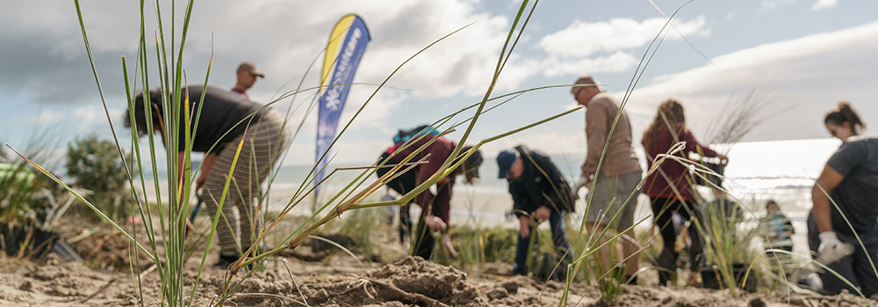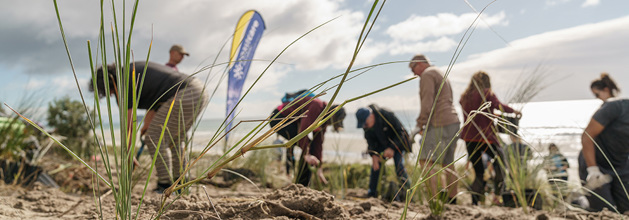Come along and help us to protect our precious dunes and have some fun at the same time!
Keep up to date with upcoming events on the Coast Care Bay of Plenty Facebook page.


Coast Care is a coastal restoration programme, run in close partnership with local communities, local authorities and schools that aims to restore and protect the sand dunes along our Bay of Plenty beaches.
Volunteers who care about our coastal environment like residents, beach users and schools, give their time and expertise to looking after our dunes. Council provides most of the funding for Coast Care, as well as other resources and educational tools.
All four coastal district and city councils (Western Bay of Plenty, Tauranga, Ōpōtiki and Whakatāne) and the Department of Conservation are also involved in the programme. Coast Care volunteers help with beach clean-ups, planting native dune plants, managing the spread of weeds and pests, fencing and much more. Coast Care offers advice on reducing erosion through planting and also provides resources such as native plants and fertiliser. Part of Coast Care’s role is also to educate people on why caring for our dunes is such an important part of protecting our beaches and that we all have a responsibility to our environment.
Volunteers are invited to come and help at our Coast Care Bay of Plenty community planting days (see upcoming events below).
Digging in the sand is quite easy and dune restoration can be enjoyable and rewarding. You'll be doing your bit for our native plants and animals and working with like-minded locals who care about the environment. All you need to bring is covered sturdy footwear, suitable clothing, gardening gloves and favourite spade.
Would you like to receive updates of Coast Care initiatives in your local area and learn more about how to protect and restore the coastal environment in the Bay of Plenty? Fill in our form online to join the mailing list and receive details of events in your area and learn more about how you can help with the protection and restoration of the coastal environment.
Bay of Plenty communities were asked to have their say about what matters most to them about their coast to help guide the work of Coast Care into the future. The survey was last held in 2014 however since then the programme has evolved, with the results from the 2023 survey helping to ensure the programme is on the right track. The survey was carried out in August and September and received 618 individual responses to a series of 22 questions. Responses were analysed and compared to previous surveys completed between 2009 and 2014.
The results confirmed many of the themes and trends from these prior surveys, you can read the full report.
Keep up to date with upcoming events on the Coast Care Bay of Plenty Facebook page.
The dunes are the backbone of our beaches, the buffer between the land and the sea. Healthy dunes are wide, gently sloping and have many dune plants to help anchor them. We now know that native dune plants play a vital role in maintaining the dunes, binding light blowing sand onto the beach, and making stable sand dunes. Without these plants, the sand blows away and dunes disappear - leaving the land vulnerable to weather and wave surges.
The popularity of our beaches, changing climate, pests and development pressure are all affecting the health of our coast, particularly dunes. This makes the work of Coast Care groups even more important in making sure our beaches remain for many more years to come.
Dunes not only provide a buffer between land and sea, they also play an important part of New Zealand’s coastal biodiversity and we have a responsibility to make sure they are protected.
Sucess Stories
Coast Care Bay of Plenty works to restore our natural coastal environment. Listed below are some examples of the work that has gone into our region showing how the planting of native sand binding plants on the dunes can improve the buffer between the land and the sea.
Life's a Beach is a teaching resource about the beach environment - the sea, beach, sand dunes, dune vegetation and reserve areas. The resource covers a wide range of curriculum areas with an emphasis on science and social science. The resource can be used (or adapted for use) for levels two - eight.
Check out the Life's a Beach resource in our teacher resources section.
Alternatively, you can contact our Restoration Coordinators for the following areas:
